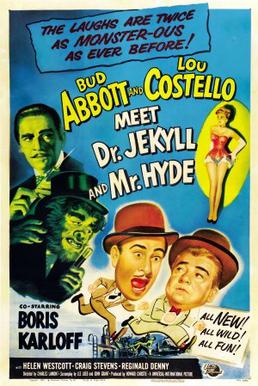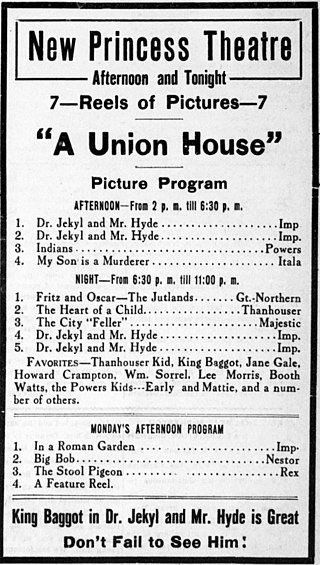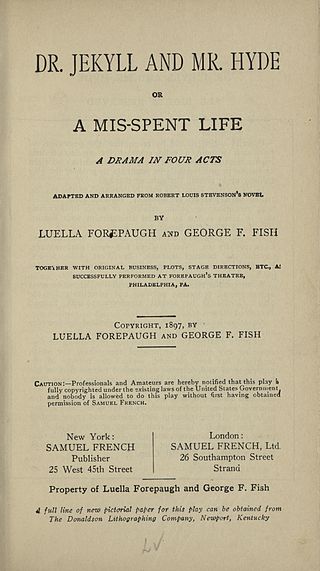
Dr. Jekyll and Mr. Hyde is a 1931 American pre-Code horror film, directed by Rouben Mamoulian and starring Fredric March, who plays a possessed doctor who tests his new formula that can unleash people's inner demons. The film is an adaptation of The Strange Case of Dr. Jekyll and Mr. Hyde, the 1886 Robert Louis Stevenson tale of a man who takes a potion which turns him from a mild-mannered man of science into a homicidal maniac.

Dr. Henry Jekyll, nicknamed in some copies of the story as Harry Jekyll, and his alter ego, Mr. Edward Hyde, is the central character of Robert Louis Stevenson's 1886 novella Strange Case of Dr Jekyll and Mr Hyde. In the story, he is a good friend of main protagonist Gabriel John Utterson.

Stan Laurel was an English comic actor, writer and film director who was one half of the comedy duo Laurel and Hardy. He appeared with his comedy partner Oliver Hardy in 107 short films, feature films and cameo roles.

Dr. Jekyll and Mr. Hyde is a 1941 American horror film starring Spencer Tracy, Ingrid Bergman, and Lana Turner. The production also features Donald Crisp, Ian Hunter, Barton MacLane, C. Aubrey Smith, and Sara Allgood. Its storyline is based on the 1886 Gothic novella Strange Case of Dr Jekyll and Mr Hyde written by Scottish author Robert Louis Stevenson. There have been many filmed adaptations of the novella. This movie was a remake of the Oscar-winning 1931 version starring Fredric March.

Joe Rock was an American film producer, director, actor, and screenwriter. He produced a series of 12 two reel short subject comedies starring Stan Laurel in the 1920s.
Dr. Jekyll and Mr. Hyde, or Strange Case of Dr Jekyll and Mr Hyde, is a 1886 novella by Robert Louis Stevenson.

Dr. Jekyll and Mr. Hyde is a 1920 American silent horror film produced by Famous Players–Lasky and released through Paramount/Artcraft. The film, which stars John Barrymore, is an adaptation of the 1886 novella Strange Case of Dr Jekyll and Mr Hyde by Robert Louis Stevenson. John S. Robertson directed the production, and Clara Beranger wrote the screenplay, based on the 1887 stage play by Thomas Russell Sullivan that in turn was based on the novel.

Abbott and Costello Meet Dr. Jekyll and Mr. Hyde is a 1953 American horror comedy film starring the comedy team of Abbott and Costello, co-starring Boris Karloff, and directed by Charles Lamont.

Dr. Jekyll y el Hombre Lobo, also known as Dr. Jekyll and the Werewolf, is a 1971 Spanish horror film, the sixth in a series of 12 films about the werewolf Count Waldemar Daninsky, played by Paul Naschy. Naschy actually plays a triple role in the film, portraying Waldemar Daninsky, the Wolf Man and Mr. Hyde. This was Naschy's 2nd film working with director Leon Klimovsky, following their hugely successful 1970 collaboration La Noche de Walpurgis. This film also featured Euro-Horror star Jack Taylor, Mirta Miller and the beautiful Shirley Corrigan of England. The film failed however to reach the box office success of Walpurgis.

Alpha Video is an entertainment company founded in 1985 as New Age Video, based near Philadelphia, that specializes in the manufacturing and marketing of public domain movies and TV shows on DVD. Alpha Video releases approximately 30 new DVD titles monthly and has over 3,500 DVDs in their active catalog, including hundreds of rare films and TV shows from Hollywood's past.

Dr. Jekyll and Mr. Hyde is a 1908 silent horror film starring Hobart Bosworth, and Betty Harte in her film debut. Directed by Otis Turner and produced by William N. Selig, this was the first film adaptation of Robert Louis Stevenson's 1886 novel Strange Case of Dr Jekyll and Mr Hyde. The screenplay was actually adapted by George F. Fish and Luella Forepaugh from their own 1897 four act stage play derived from the novel, causing a number of plot differences with the original source. Despite Stevenson's protests, this film became the model which influenced all the later film adaptations that were to come.

Dr. Jekyll and Mr. Hyde is a 1920 horror film directed and written by J. Charles Haydon, starring Sheldon Lewis, based on the 1886 novel Strange Case of Dr. Jekyll and Mr. Hyde by Robert Louis Stevenson. The Sheldon Lewis version was somewhat overshadowed by the 1920 Paramount Pictures version starring John Barrymore, which had been released just the month before.

Dr. Jekyll and Mr. Hyde is a 1913 horror film based on Robert Louis Stevenson's 1886 gothic novella Strange Case of Dr. Jekyll and Mr. Hyde. Directed by Herbert Brenon for producer Carl Laemmle's company IMP, the production stars King Baggot in the dual role of Jekyll and Hyde. The film was re-released in the United States in August 1927.

Dr. Jekyll and Ms. Hyde is a 1995 science fiction comedy film directed by David Price, based on Robert Louis Stevenson's 1886 horror novella Strange Case of Dr Jekyll and Mr Hyde. It stars Sean Young, Tim Daly, and Lysette Anthony. The story takes place in modern times and concerns a bumbling chemist who tampers with his great-grandfather's formula, accidentally transforming himself into a beautiful businesswoman who is determined to take over his life.

Jekyll and Hyde...Together Again is a 1982 sex comedy based on the 1886 novella Strange Case of Dr. Jekyll and Mr. Hyde by Robert Louis Stevenson and stars Mark Blankfield, Bess Armstrong, Tim Thomerson, Krista Errickson, Cassandra Peterson, and Michael McGuire.

The Son of Dr. Jekyll is a 1951 American horror film directed by Seymour Friedman and starring Louis Hayward, Jody Lawrance and Alexander Knox. The film is a continuation of Robert Louis Stevenson's original classic 1886 novella Strange Case of Dr. Jekyll and Mr. Hyde.

Strange Case of Dr Jekyll and Mr Hyde is an 1886 novella written by the Scottish author Robert Louis Stevenson. It is about a London lawyer, Gabriel John Utterson, who investigates strange occurrences between his old friend, Dr. Henry Jekyll and the misanthropic Mr. Hyde. In a twist ending, it is revealed that Jekyll and Hyde were the same person, and that Jekyll had regularly transformed himself into Hyde by drinking a serum.

The Test of Honor (1919) was an American silent film drama produced by Famous Players–Lasky, released by Paramount, directed by John S. Robertson, and starring John Barrymore. Considered the actor's first drama movie role after years of doing film comedies and farces. It is based on author E. Phillips Oppenheim 1906 novel The Malefactor.

Strange Case of Dr Jekyll and Mr Hyde is an 1886 Gothic novella by Scottish author Robert Louis Stevenson. It follows Gabriel John Utterson, a London-based legal practitioner who investigates a series of strange occurrences between his old friend, Dr Henry Jekyll, and a murderous criminal named Edward Hyde.

Dr. Jekyll and Mr. Hyde, Or a Mis-Spent Life is a four-act play written in 1897 by Luella Forepaugh and George F. Fish. It is an adaptation of Strange Case of Dr Jekyll and Mr Hyde, an 1886 novella written by the Scottish author Robert Louis Stevenson. The story focuses on Henry Jekyll, a respected London doctor, and his involvement with Edward Hyde, a loathsome criminal. After Hyde murders a vicar, Jekyll's friends suspect he is helping the killer, but the truth is that Jekyll and Hyde are the same person. Jekyll has developed a potion that allows him to transform himself into Hyde and back again. When he runs out of the potion, he is trapped in his Hyde form and commits suicide.


















